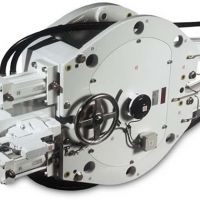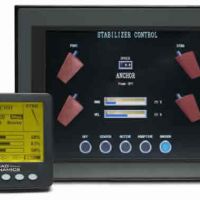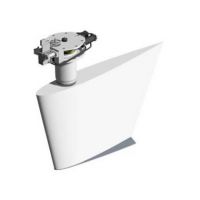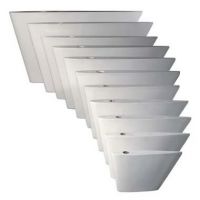NAIAD ROLL STABILIZATION
All vessels have their own roll period depending on hull shape and loading. Wave motions initiate this roll and, if in close synchronization with the hull’s natural roll period, roll may build to uncomfortable or even dangerous proportions.
The principle behind NAIAD fin stabilization is to counteract the tendency of a vessel to roll with an equivalent and opposite righting moment applied in exactly the proper phase and proportion. These righting moment forces are typically generated from a pair of underwater fins, although other control surfaces are also available. Wave forces are thus prevented from aggravating the vessel’s natural tendency to roll.
A rolling boat does not operate at maximum efficiency and over a long course, steers a zigzag track. With the advanced NAIAD active roll stabilizer system, a vessel steers a nearly straight course, often actually improving fuel economy.
-
An anchored yacht subjected to a swell (long waves) with a frequency at or near the yacht’s natural roll period will roll unpleasantly. NAIAD’s Stabilization at Anchor system detects this rolling with a very sensitive motion sensor package. The controller processes the signals from the motion sensor package and commands a calibrated signal to electro-hydraulic servo valves causing immediate rotation of the fins, which generate a substantial force. By timing the fin movement in perfect phase with the roll motion (acceleration, angular speed and deceleration) a righting moment is applied to the vessel, which dampens the vessel’s tendency to roll.
To optimize the overall effectiveness of these systems, NAIAD offers specially designed fins with a different planform and aspect ratio. The fins also include our Tip Fence to maximize the efficiency of the fins. In addition, the fins feature significant internal structural reinforcement to allow them to withstand the additional load endured in S@A operation. These larger, specially shaped fins require higher operational torque, which is easily provided by NAIAD Fin Actuator Assemblies and hydraulic circuits.
-
NAIAD fin movement is commanded by a control system that senses the vessel’s motions and issues precise control commands to the rest of the Roll Stabilizer System in proportion to those motions. As the controller senses the slightest roll motion, the fins respond instantly and in exactly the proper proportion to neutralize the vessel’s tendency to roll, without over-or under-correcting. NAIAD fins stop rotating the moment the roll tendency has been neutralized, regardless of their position or the vessel’s speed at the time. NAIAD systems have been proven to automatically reduce roll motion by up to 90% over a wide range of vessel operating speeds.
NAIAD systems are available to control vessel Roll while underway ("Active Roll Stabilization"), to control Roll at zero speed ("Stabilization at Anchor"), and to control Roll, Pitch, Yaw and other undesirable vessel motions ("Ride Control"). NAIAD control systems may also be retrofitted to existing stabilizer systems ("Stabilizer Control Conversions").
-
The NAIAD Fin Actuator Assembly is designed for efficiency, power and rugged reliability. It is supplied completely factory tested under pressure, assembled and ready for installation including all required hardware and fittings. Unlike other systems, no disassemble is required for installation. NAIAD Fin Actuator Assemblies are recognized the world over as the industry standard for excellence.
Click on model name to download the related document.
Model Vessel Length Max. Displacement Fin Range Model 162 30-42ft. (9-13m) 25 S. Tons(23 M. Tons) 3-4.5ft² (0.28-0.42m²) Model 174 32-50ft. (10-15m) 35 S. Tons (32 M. Tons) 3-6ft² (0.28-0.56m²) Model 252 45-75ft. (13-23m) 50 S. Tons (45 M. Tons) 3-7.5ft² (0.28-0.70m²) Model 254 55-85ft. (16-26m) 80 S. Tons (73 M. Tons) 3-9ft² (0.28-0.84m²) Model 302 80-100ft. (24-31m) 140 S. Tons (130 M. Tons) 4.5-12ft² (0.42-1.12m²) Model 320 80-100ft. (24-31m) 140 S. Tons (130 M. Tons) 4.5-12ft² (0.42-1.12m²) Model 360 90-120ft. (27-37m) 200 S. Tons (185 M. Tons) 7.5-19ft² (0.70-1.76m²) Model 420 110-140ft. (33-43m) 400 S. Tons (365 M. Tons) 9-22ft² (0.84-2.04m²) Model 525 130-160ft. (39-49m) 600 S. Tons (545 M. Tons) 12-38ft² (1.12-3.53m²) Model 575 135-170ft. (41-52m) 675 S. Tons (610 M. Tons) 16-45ft² (1.49-4.18m²) Model 621 140-180ft. (42-55m) 750 S. Tons (680 M. Tons) 19-45ft² (1.76-4.18m²) Model 720 150-200ft. (45-61m) 1000 S. Tons (910 M. Tons) 22-53.8ft² (2.04-5.00m²) Model 820 180-280ft. (54-85m) 1500 S. Tons (1360 M. Tons) 45-75.3ft² (4.18-7.00m²) Model 925 200-320ft. (90-152m) 2000 S. Tons (1800 M. Tons) 63.8-86.1ft² (5.00-8.00m²)




